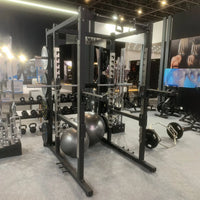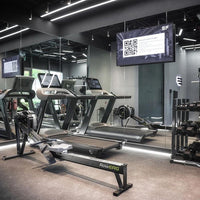Why Pilates Works for Back Pain Relief
Back pain—whether chronic or occasional—can be debilitating. Common causes include poor posture, sedentary habits, weak core muscles, and spinal misalignment. Fortunately, Pilates exercises, especially those performed on a Pilates machine like the reformer, can be beneficial.
Pilates focuses on controlled movement, alignment, and core strength—all crucial for a healthy back. By engaging the deep abdominal muscles, glutes, and spinal stabilisers, Pilates enhances flexibility and posture, thereby reducing the strain on your spine.
Best Pilates Exercises for Back Pain Relief
These exercises can be performed using a Pilates reformer machine, which offers resistance through springs and pulleys, making each movement smooth and low-impact.
1. Pelvic Curl (Spinal Mobility + Core Activation)
How to Do It:
Lie on your back on the reformer carriage with feet flat on the footbar, knees bent. Inhale, then exhale and roll your spine off the carriage one vertebra at a time. Inhale at the top, exhale to roll back down.
Benefits:
-
Mobilizes spine
-
Strengthens glutes and lower back
-
Enhances pelvic stability
2. Footwork Series (Postural Alignment)
How to Do It:
Lying down on the reformer, place feet on the footbar (parallel, heels down). Press the carriage out using leg strength, keeping the pelvis stable. Repeat 10–15 reps.
Benefits:
-
Aligns hips and spine
-
Strengthens quads, glutes, and calves
-
Encourages even weight distribution
3. Swan on the Long Box (Back Extension)
How to Do It:
Place a long box on the reformer. Lie on your stomach, hips over the edge, hands on the footbar. Inhale to prepare, exhale to lift your chest using back extensors, then slowly return.
Benefits:
-
Builds lumbar strength
-
Improves posture
-
Stretches abdominal muscles
4. Kneeling Arm Series (Core + Shoulder Stability)
How to Do It:
Kneel facing the front of the reformer, holding the straps. With neutral spine and tight core, extend arms forward or sideways and resist them back.
Benefits:
-
Strengthens upper back and core
-
Improves shoulder alignment
-
Enhances balance and control
5. Cat-Cow Stretch (Spinal Flexibility)
How to Do It:
Use the reformer platform for support. On all fours, inhale to arch your back (cow), exhale to round (cat). Repeat for several breaths.
Benefits:
-
Gently mobilizes spine
-
Relieves tension
-
Promotes awareness of spinal movement
Who Should Avoid Pilates Exercises?
While Pilates offers numerous benefits, it’s not suitable for everyone—especially those with specific medical conditions. People with the following health concerns should avoid or consult a physician before starting Pilates exercises, especially on a Pilates machine:
-
Severe Osteoporosis: Risk of spinal fractures during flexion-based exercises
-
Herniated Discs: Certain spinal movements may aggravate nerve impingement
-
Acute Back Injuries or Post-Surgical Recovery: Avoid exercise until cleared by a doctor
-
Uncontrolled Hypertension: Inversion or breath-holding may spike blood pressure
-
Vertigo or Balance Disorders: Risk of falls on unstable equipment
-
Chronic Pain Conditions (e.g., Fibromyalgia): Intensity may need major modification
Pregnant women should only perform prenatal Pilates routines designed for their trimester. Always consult a certified Pilates instructor and healthcare provider before beginning any program.
Tips for Doing Pilates Safely with Back Pain
-
Start Slow: Begin with gentle, mat-based exercises before progressing to reformer use.
-
Focus on Form: Keep a neutral spine and avoid over-flexing or over-extending the lower back.
-
Use Light Resistance: Choose low spring settings on the reformer until stability improves.
-
Don’t Force Movements: Back pain can worsen if you push through pain. Modify as needed.
-
Warm Up and Cool Down: Prepare your spine with light stretches and end with relaxing mobility work.
Why a Pilates Machine Makes a Difference
Using a Pilates machine, especially a reformer, adds smooth resistance and guided movement to help people recovering from injury or managing pain. It allows for:
-
Low-impact strength building
-
Customizable resistance levels
-
Assisted stretches that don’t strain the back
-
Safer alignment through guided movement paths
Garner offers a wide selection of reformers, towers, and accessories designed for all levels—from beginners to rehab clients. With premium build quality and adjustable features, these machines are ideal for anyone looking to reduce back pain and improve posture.
Conclusion: Heal and Strengthen with Purpose
If you're recovering from back pain or simply trying to prevent it, Pilates exercises on a Pilates machine can be a game-changer. By focusing on alignment, strength, and breath control, Pilates not only relieves pain but builds a strong foundation for long-term spine health.
But remember—always consult your physician and work with a certified instructor, especially if you're dealing with existing injuries. With consistent practice and the right equipment, you can restore your posture, build strength, and move pain-free again.




0 comments